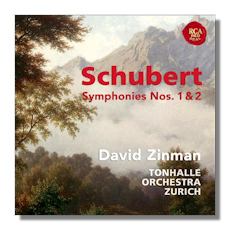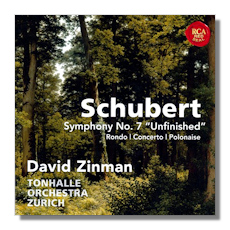
The Internet's Premier Classical Music Source
Related Links
- Schubert Reviews
- Latest Reviews
- More Reviews
-
By Composer
-
Collections
DVD & Blu-ray
Books
Concert Reviews
Articles/Interviews
Software
Audio
Search Amazon
Recommended Links
Site News
 CD Review
CD Review
Franz Schubert

Symphonies
- Symphony #1 in D Major, D. 82
- Symphony #2 in B Major, D. 125
Tonhalle Orchestra Zürich/David Zinman
RCA 88697-87147-2 59min


- Symphony #7 "Unfinished" in B minor, D. 759
- Rondo in A Major for Violin & Strings, D. 438
- Polonaise in B Major for Violin & Orchestra, D. 580
- Konzertstück for Violin & Orchestra, D. 345
Andreas Janke, violin
Tonhalle Orchestra Zürich/David Zinman
RCA 88697-95335-2 52min
For his Schubert symphony cycle David Zinman, conductor of the Tonhalle Orchestra Zürich since 1995, has gone back to the original scores. This fact means, for example, that the first movement repeat of the First Symphony is taken, something not usually done. Zinman also uses original instruments and employs historic performance practices.
Actually as far as instrumental sound is concerned, I would say that the average listener will not notice huge differences between these efforts and recorded performances played on modern instruments. What most listeners familiar with these scores are likely to notice, however, is Zinman's extremely brisk tempos in the "Unfinished Symphony." Numbered Symphony #7 here and in parts of Europe (in the US, UK and probably most of the rest of the world it has always been listed as the Symphony #8), Zinman leads a fleet, splendidly played version of the work. Clocking in at just over twenty-one minutes, it is a good four or five minutes faster than the average performance.
That observation alone will deter some from acquiring the disc, but Schubert mavens, and that's many of us, will want this highly charged performance not least because we can hear the symphony in a new way, where the mixture of darkness and agitation unite to give the first movement a fateful sense, the music often seeming to strike a pose where a forced smile is fighting back a grimace. You might think the faster tempos would lighten the mood a bit, but the opening theme's anxiety is heightened and the alternate theme darkens. The second movement is also tense, with a sense of foreboding, especially in the alternate theme, which comes across with a greater sense of desolation. The playing by the orchestra throughout is precise and spirited.
The three works for violin and orchestra that fill out the disc are all light and very well played by Andreas Janke, who is the concertmaster of the Tonhalle Orchestra. He commands a clean and precise technique and catches the elegance and brightness of the Rondo, the best of the three violin works here. While it is light in mood, it offers music of considerable substance and a couple of truly memorable themes. Janke's sprightly version of the Polonaise is splendid, and his rendition of the Konzertstück deftly catches the high spirits and gentility of the work. Zinman draws fine performances from the orchestra in all three works and the sound reproduction is excellent.
The first two Schubert symphonies are often damned with faint praise. Really, though, they're charming, rather delightful works from Schubert's youth. There I go, damning with faint praise. The first movement of the First Symphony is quite attractive but lopsided in favor of the alternate theme, which has rightly been singled out as bearing an uncomortably close resemblance to the theme in the finale of Beethoven's Eroica Symphony. But the whole work is quite spirited and a major accomplishment for the then-sixteen-year-old composer. The Second Symphony is perhaps a marginally better work: the first movement development section is more sophisticated and the whole work is conceived on a grander scale. Coming a year after the First, it is the product of a composer who was still developing his skills. Both works get brisk readings from Zinman, though the tempo selections in these two symphonies are closer to the mainstream. He catches the youthful spirit and sunshine permeating these works and his orchestra plays with precision and feeling throughout. Again, the sound reproduction is excellent. Among the competition Jonathan Nott with the Bamberger Symphoniker on Tudor offer solid, spirited and more traditional readings. The rest of Zinman's cycle ought to be interesting, and the way it is shaping up, I would say it will likely be viewed as a fresh, though perhaps not radically different view of these symphonies.
Copyright © 2012 by Robert Cummings.





















